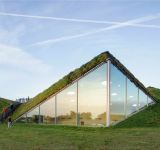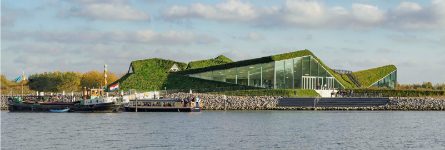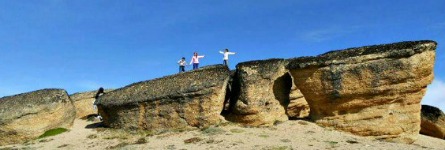Discover "the Ruta Azul" in the Argentine Patagonia |
|||||||||||||||
| 13/12/2013 | 0:00 | Ruta Azul, the most novel touristic circuit in the Argentine Patagonia, comprises 500 kilometers of protected areas in the Atlantic coast and is home to a unique sea fauna. | |||||||||||||||
|
|||||||||||||||
|
|
|||||||||||||||
|
Magellanic penguins, elephant seals, cormorants and orcas invite to go round this new touristic destination in the Argentine Patagonia's coasts. It consists of protected areas between the provinces of Chubut and Santa Cruz which, in 500 kilometers, passes through three “blue parks”. The journey goes through National Route 3 and encompasses the major cities of Comodoro Rivadavia, province of Chubut, and Río Gallegos, in the neighboring province of Santa Cruz. The first one is considered the most important in the region because it offers good services and infrastructure, and has an international airport. In the second one, travelers find the mythical Ruta Nacional 40 (National Route 40), which connects almost the whole country, from North to South. The coastal itinerary proposed by Ruta Azul connects, along 500 kilometers, recognized protected areas called “blue parks”, in contrast to the “green parks” which make up the Andean Patagonia. This journey constantly combines the steppe with the Atlantic horizon. A sea novelty One of the first cities to visit is Camarones, starting point of the Bioceanic Corridor, recognized for its fishing and diving activities, as well as for its National Festival of the Salmon, which is celebrated in February every year. Originally founded as Nueva León, in 1535, this city in Chubut was also home to the three-times president of Argentina, Juan Domingo Perón, during his childhood. This fact gave rise to the creation of the Museo Provincial “Familia Perón” (Familia Perón Provincial Museum), which can be visited for free everyday from 8 a.m. to 8 p.m. Moreover, in this port city, the Parque Marino Costero Patagonia Austral (Patagonia Austral Coastal Marine Park) was created four years ago. It consists of approximately 130,000 protected hectares that cover hundreds of kilometers of the coasts of the Cabo Dos Bahías and the Bahía Bustamante, as well as 60 islands and islets. It is a reserve that protects about 40 species of birds and 10 species of mammals including penguins, steamer ducks, whales, guanacos, ñandúes and sea lions. Located in the South of the province of Chubut, the Parque Marino Costero preserves the biodiversity of the North of the Golfo San Jorge (San Jorge Gulf), and was considered a novelty in Argentina since it was the first area protected nationwide with jurisdiction in the sea. Following Darwin's steps The next touristic destination along the Ruta Azul is Puerto Deseado, a city with a topography of eccentric characteristics, since it has the only South American river with an abandoned riverbed that was occupied by the sea. This area was visited by the tireless investigator Charles Darwin more than a century ago. Founded around the fishing port that brought it to life, Puerto Deseado offers, in the Northeast of the province of Santa Cruz, nautical and ground tours that go through the Parque Interjurisdiccional Marino Isla Pingüino (Isla Pingüino Marine Interjurisdictional Park), created in 2009 to protect more than 140,000 hectares of oceanic surface, as well as other areas that invite to practice local flora and fauna watching. • The tour starts in the Refugio de Vida Silvestre (Wild Life Refugee), better known as the Cañadón del Duraznillo. Located about 120 kilometers away from the city, it hosts guanacos, choiques and eagles. From there, travelers can visit the Reserva Científica Monte Loayza (Monte Loayza Scientific Reserve), the biggest continental lobería (sea lions spot) of the province. • Nearer to the city, you can find Cabo Blanco, the refuge of the South American fur seal. It is an area protected since 1937, where the Patagonian steppe xerophile flora stands out. • Among the most relevant places, we can find the Reserva Natural Ría Deseado (Ría Deseado Natural Reserve). It is a geographic rarity which thousands of years ago, in a 40 kilometers riverbed, let the sea water enter the continent, and it is the natural habitat of Magellanic penguins, petrels and flamingos. • The Reserva Provincial Isla Pingüino (Isla Pingüino Provincial Reserve) is located in the South coast, 24 kilometers away from the city, and it is the preferred living place for a colony of yellow crest penguins. • Finally, between the lighthouses of Puente Mercedes and Cabo Guardián, is Bahía Laura, the nesting place of Kelp gulls, crested ducks, and casual Commerson's dolphins. • Departing from the usual itinerary of the Ruta Azul, another recommended destination 250 kilometers away from Puerto Deseado is the Bosque Petrificado Jaramillo (Jaramillo Petrified Forest), one of the most important fossil sites in Argentina, declared to be a Natural Place of Interest in 1954. A must visit On the way to Puerto Santa Cruz, where the southernmost marine park of all the parks that currently make up the Ruta Azul is located, it is worth making an additional stop in Puerto San Julián's city, located down by a bay that goes into the Patagonian plateau. This city is famous for having been a base of operations during the Falkland War. The biodiversity found in the surroundings of Puerto San Julián also gave rise to a Natural Reserve, located about 25 kilometers away from the city center, where local species of the Patagonian steppe like guanacos, ñandúes and foxes can be found. As regards sea fauna, it is possible to see Commerson's dolphins, Magellanic penguins and two non-reproductive loberías: one near La Mina beach, and the other in the Estancia Makenke's beaches. Among the must-do tours in Puerto San Julián we can mention: the Museo Temático Nao Victoria (Nao Victoria Theme Museum), an actual-size replica of a boat that arrived on March 31, 1520 with the Magellanic fleet; and the Muestra Arqueológica Florida Blanca (Florida Blanca Archeologic Exhibition), with specimens more than 13,000 years old. Circuit's end The last destination of the Ruta Azul is Puerto Santa Cruz, located down by the estuary of the river with the same name. It is a town that became the first provincial capital city and had an important role during the reinforcement of Argentinean sovereignty in the South area of the country. Starting in 2004, this city hosts the Parque Nacional Monte León (Monte León National Park), which is the driving force of the local touristic development. Established on a Patagonian wool ranch, the house of which was granted to build the administrative offices, it protects more than 68,000 hectares and 40 kilometers of coast lands. The park's tracks lead to a site chosen by the South American sea lions to reproduce themselves; the Monte León island viewpoint and the old guano deposit; and the fourth most important colony of Magellanic penguins of the country, where more than 60,000 specimens live. Within the park, there is a camp area, and from there, if water goes out, the island can be accessed on foot. This island gives shelter to cormorants, sea gulls, oystercatchers, bandurrias (kind of pelican), cauquenes (native birds), and flamingos. In the sea, it is possible to see southern right whales, orcas and dolphins. The visitor's center was built in a storehouse used to shear sheep; and the ranch house is currently used as a hostel. How to arrive From Buenos Aires to Comodoro Rivadavia travelling 1,839 kilometers by car, along the same National Route 3 which connects the Ruta Azul. By plane, you can get to Comodoro Rivadavia. Flights are operated by the following airlines: Lan, Aerolíneas Argentinas, Lade and Sol. To Puerto Deseado, about 2,099 kilometers from Buenos Aires and 1,191 kilometers from Bariloche, through Routes 3 and 281. From Buenos Aires to Puerto San Julián, driving approximately 2,252 kilometers also through National Route 3. Although there is an airport in Puerto San Julián, the only flights available are operated by LADE on Thursdays. There are connection flights with other airlines from Comodoro Rivadavia or Río Gallegos. |
|||||||||||||||
|
|||||||||||||||
|
|||||||||||||||
|
|||||||||||||||
Comentarios (0)
|
|||||||||||||||
EcoPulso


Conocé un museo sustentable
El Museo Biesbosch, ubicado en los Países Bajos fue re diseñado teniendo en cuenta el entorno natural donde está ubicado.
leer nota completa
